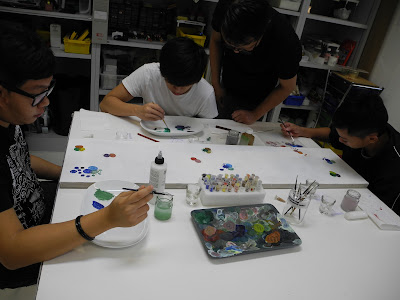Diary of an NUS Museum Intern: Andrew Lee
Note: Diary of an NUS Museum Intern is a series of blog posts written by our interns about their experiences during the course of their internships. Besides working hard and fast in their cubicles, our interns have travelled to Bandung and Malacca, organised symposiums, waded through tons of historical research and pitched in during exhibition installations. It was definitely no ordinary internship for them! If you would like to become our next intern, visit our internship page for more information!
For our next two intern diary entries, we will be featuring interns from the Conservation Studio, our on-site conservation lab. Kicking off this two-parter is Andrew Lee from the LASALLE College of the Arts where he is currently pursuing a degree in Arts Management.
Stretching canvas, cleaning artwork, repairing surfaces, these are just some of the things I have learned from my attachment with The Conversation Studio at the NUS Museum. As an arts management student, I often frequent museums for projects and have always seen exhibitions in perfect condition. However, I was unaware of the amount of labour that must be done before an exhibit can be set up. This attachment has allowed me to put my theory knowledge of conservational studies into a practical use and has made me realize the importance of conservation work.
It has been a delight to have the opportunity to work on an upcoming exhibition during my internship. I was given the task of assisting during the set up of the artworks and while it seems like a simple job, it was manually challenging as well. It also opened my eyes to realise that a minor detail could cause a cascade of reactions. For example, drilling a hole that is 1mm off the actual measurement could disrupt the aesthetics of the layout. I have also learnt that precautions are highly essential, despite it seeming like a minor issue.
For our next two intern diary entries, we will be featuring interns from the Conservation Studio, our on-site conservation lab. Kicking off this two-parter is Andrew Lee from the LASALLE College of the Arts where he is currently pursuing a degree in Arts Management.
Stretching canvas, cleaning artwork, repairing surfaces, these are just some of the things I have learned from my attachment with The Conversation Studio at the NUS Museum. As an arts management student, I often frequent museums for projects and have always seen exhibitions in perfect condition. However, I was unaware of the amount of labour that must be done before an exhibit can be set up. This attachment has allowed me to put my theory knowledge of conservational studies into a practical use and has made me realize the importance of conservation work.
Before a conservator can start cleaning an artwork, many considerations must be made before to prevent any misjudgements that might cause the artwork to be damaged and unable to be restored to its original condition. Conservators must see beyond the surface damage and stabilise the paintings before they are able to proceed with the repairing of the artwork. It is easy to take it for granted that paintings are in prime conditions. Hence it is vital to know that deterioration is happening at every moment and that many works could have been lost without the perseverance of the conservators. In addition, I have learnt much more about the different characteristics of various art materials such as their reaction time and their basic properties.
Conservators are truly the unsung heroes of the art scene because this uncommon occupation has provided us with a never ending continuation of beautiful artworks to admire. We often speak highly of the artists who have created the artwork, but little has been mentioned about the conservator, who constantly tries to preserve the works of art. During this six-week attachment, I have not only been constantly learning, but also enhancing and achieving my overall career goal as a visual arts manager, I now have a better understanding of the museum environment, the conservation of artworks and conservation work itself. Although it was for a very short period of time, I have truly enjoyed my experience at The Conservation Studio and I hope that I will have more opportunities in the future to work with them and to increase awareness on the importance of conservation works. Visits to museums and art galleries will never be the same again with the new insights I have – always remembering the tremendous efforts by conservators to preserve art for many generations to come.




Comments
Post a Comment